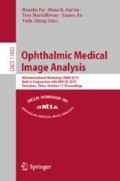Abstract
Biomedical image segmentation plays an important role in automatic disease diagnosis. However, some particular biomedical images have blurred object boundaries, and may contain noises due to the limited performance of imaging device. This issue will highly affects segmentation performance, and will become even severer when images have to be resized to lower resolution on a machine with limited memory. To address this, we propose a guide-based model, called G-MNet, which seeks to exploit edge information from guided map to guide the corresponding lower resolution outputs. The guided map is generated from multi-scale input to provide a better guidance. In these ways, the segmentation model will be more robust to noises and blurred object boundaries. Extensive experiments on two biomedical image datasets demonstrate the effectiveness of the proposed method.
This work was done when S. Zhang and Y. Yan are interns at CVTE Research.
Access this chapter
Tax calculation will be finalised at checkout
Purchases are for personal use only
References
Chaurasia, A., Culurciello, E.: LinkNet: exploiting encoder representations for efficient semantic segmentation. In: VCIP. IEEE (2017)
Chen, L.C., et al.: DeepLab: semantic image segmentation with deep convolutional nets, atrous convolution, and fully connected CRFs. TPAMI 40, 834–848 (2018)
Chen, Q., et al.: Fast image processing with fully-convolutional networks. In: ICCV (2017)
Cheng, J., et al.: Superpixel classification based optic disc and optic cup segmentation for glaucoma screening. TMI 32, 1019–1032 (2013)
Fu, H., et al.: Joint optic disc and cup segmentation based on multi-label deep network and polar transformation. TMI 37, 1597–1605 (2018)
He, K., et al.: Guided image filtering. TPAMI 35, 1397–1409 (2013)
Hu, P., et al.: Deep level sets for salient object detection. In: CVPR (2017)
Long, J., et al.: Fully convolutional networks for semantic segmentation. In: CVPR (2015)
Ronneberger, O., Fischer, P., Brox, T.: U-Net: convolutional networks for biomedical image segmentation. In: Navab, N., Hornegger, J., Wells, W.M., Frangi, A.F. (eds.) MICCAI 2015. LNCS, vol. 9351, pp. 234–241. Springer, Cham (2015). https://doi.org/10.1007/978-3-319-24574-4_28
Sun, X., et al.: Localizing optic disc and cup for glaucoma screening via deep object detection networks. In: Stoyanov, D., et al. (eds.) OMIA/COMPAY -2018. LNCS, vol. 11039, pp. 236–244. Springer, Cham (2018). https://doi.org/10.1007/978-3-030-00949-6_28
Wong, A.L., et al.: Quantitative assessment of lens opacities with anterior segment optical coherence tomography. Br. J. Ophthalmol. 93, 61–65 (2009)
Wu, H., et al.: Fast end-to-end trainable guided filter. In: CVPR (2018)
Xu, Y., et al.: Sliding window and regression based cup detection in digital fundus images for glaucoma diagnosis. In: Fichtinger, G., Martel, A., Peters, T. (eds.) MICCAI 2011. LNCS, vol. 6893, pp. 1–8. Springer, Heidelberg (2011). https://doi.org/10.1007/978-3-642-23626-6_1
Yin, F., et al.: Model-based optic nerve head segmentation on retinal fundus images. In: EMBC. IEEE (2011)
Yin, P., et al.: Automatic segmentation of cortex and nucleus in anterior segment OCT images. In: Stoyanov, D., et al. (eds.) OMIA/COMPAY -2018. LNCS, vol. 11039, pp. 269–276. Springer, Cham (2018). https://doi.org/10.1007/978-3-030-00949-6_32
Zhao, H., et al.: Pyramid scene parsing network. In: CVPR, pp. 2881–2890 (2017)
Acknowledgements
This work was supported by National Natural Science Foundation of China (NSFC) 61602185 and 61876208, Guangdong Introducing Innovative and Enterpreneurial Teams 2017ZT07X183, and Guangdong Provincial Scientific and Technological Fund 2018B010107001, 2017B090901008 and 2018B010108002, and Pearl River S&T Nova Program of Guangzhou 201806010081, and CCF-Tencent Open Research Fund RAGR20190103, and National Key R&D Program of China #2017YFC0112404.
Author information
Authors and Affiliations
Corresponding author
Editor information
Editors and Affiliations
Rights and permissions
Copyright information
© 2019 Springer Nature Switzerland AG
About this paper
Cite this paper
Zhang, S. et al. (2019). Guided M-Net for High-Resolution Biomedical Image Segmentation with Weak Boundaries. In: Fu, H., Garvin, M., MacGillivray, T., Xu, Y., Zheng, Y. (eds) Ophthalmic Medical Image Analysis. OMIA 2019. Lecture Notes in Computer Science(), vol 11855. Springer, Cham. https://doi.org/10.1007/978-3-030-32956-3_6
Download citation
DOI: https://doi.org/10.1007/978-3-030-32956-3_6
Published:
Publisher Name: Springer, Cham
Print ISBN: 978-3-030-32955-6
Online ISBN: 978-3-030-32956-3
eBook Packages: Computer ScienceComputer Science (R0)


